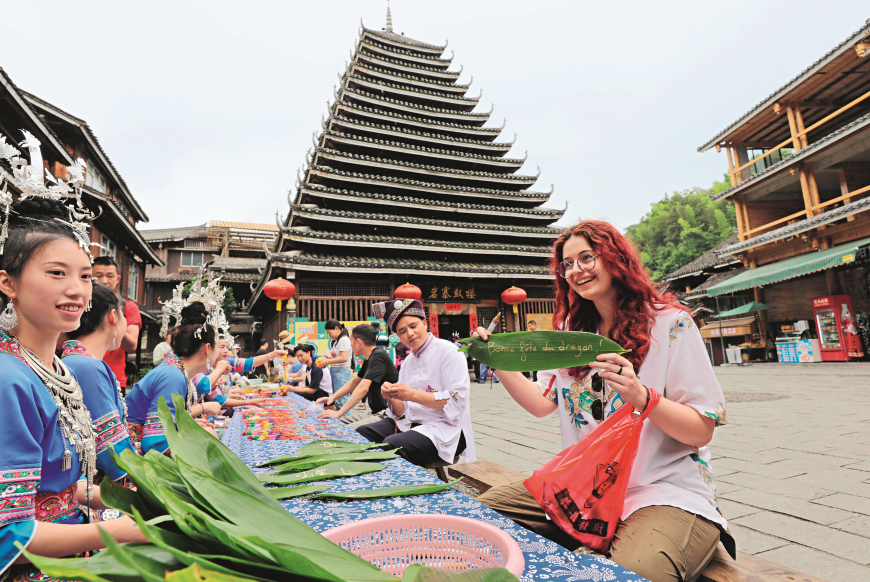“As midsummer welcomes the Dragon Boat Festival, days grow long and skies serene.” Every year on the fifth day of the fifth lunar month, the Dragon Boat Festival fills the air with a rich traditional atmosphere as people race dragon boats, eat zongzi (sticky rice dumplings), wear fragrant sachets, and hang mugwort and calamus leaves.
The Dragon Boat Festival, one of China’s four major traditional festivals, is a grand folk celebration that integrates ancestor worship, divine reverence, prayers for blessings and protection against evil, festive entertainment, and culinary traditions. With over 20 alternative names such as the Dragon Boat Festival, Double Fifth Festival, and Heavenly Midday Festival, it stands as a shared cultural symbol and emblem of the Chinese nation among all its ethnic groups.
As the first Chinese traditional festival inscribed on UNESCO’s Representative List of the Intangible Cultural Heritage of Humanity, the Dragon Boat Festival showcases the profound depth and enduring legacy of China’s outstanding traditional culture. It embodies the Chinese nation’s expression of patriotism and familial devotion. By the Miluo River, Qu Yuan’s timeless lament, “My journey is long, I’ll keep on exploring,” has echoed through millennia, transforming into the fragrance of glutinous rice in zongzi and the thunderous drumbeats of dragon boats, inspiring generations of Chinese to uphold their ideals and courageously seek truth in adversity. The mugwort in sachets not only repels insects and wards off plagues but also carries elders’ heartfelt wishes for the younger generation’s peace and prosperity.
Passed down for millennia with enduring cultural vitality, the Dragon Boat Festival connects people through its rich tapestry of folk activities—from solemn temple rites to vibrant local customs and festive atmosphere—allowing people of all ethnicities to feel the pulse of China’s outstanding traditional culture and collectively build a shared spiritual home for the Chinese nation.
Generally, the Dragon Boat Festival is closely associated with Qu Yuan. Legend holds that after Qu Yuan drowned himself in the river, people raced in boats to search for his body and threw zongzi into the water to feed the fish, lest they consume his remains. Over time, this evolved into the customs of dragon boat racing and zongzi-making. The Tang Dynasty verse, “Since ancient times it’s been said that Qu Yuan is the origin of this festival,” provides literary evidence for this narrative, cementing the link between Qu Yuan and the Dragon Boat Festival.
In reality, however, the origins of the Dragon Boat Festival are not so singular. Archaeological discoveries, such as bronze battle-axes from the Spring and Autumn Period (770-476 BCE) and bronze drums from the Warring States Period (475-221 BCE), depict scenes of dragon boat racing, proving the custom predates Qu Yuan and was tied to sacrificial rituals. Qu Yuan’s own work, The Songs of Chu · Nine Songs, includes the line, “I bathe in orchid-scented water and wash my hair with fragrant herbs,” describing the ancient custom of bathing in herbal decoctions on the fifth day of the fifth month during the Warring States Period, aimed at dispelling evil and warding off misfortune. Therefore, attributing the festival’s origin solely to commemorating Qu Yuan reflects more a cultural sentiment than historical fact.
The festival’s roots also lie in ancient southern Chinese customs of expelling plague spirits during spring. As the fourth and fifth lunar months brought increasingly hot and humid weather to southern regions, disease outbreaks became common—captured vividly in the saying, “When loquats turn yellow, doctors grow busy.” To drive away plagues, people would place effigies of plague deities into paper boats and set them adrift downstream, symbolically “sending away” the evil. While individual households conducting this ritual might pass unnoticed, when entire villages participated simultaneously, a competitive spirit emerged—the faster one rowed, the sooner one’s community would be free of the plague deity’s grip. This likely gave rise to the grand and spectacular dragon boat races we see today.
Other theories about the festival’s origins exist. Scholar Wen Yiduo, in his works Research on the Dragon Boat Festival and The Historical Education of the Dragon Boat Festival, proposed that the festival originated as a totemic sacrifice day for the ancient “dragon” tribes in the Wu-Yue region (modern Jiangsu, Zhejiang, and surrounding areas). Another view connects it to commemorating the filial daughter Cao E. According to the Eastern Han Dynasty (25-220 CE) Stele of Cao E, her father drowned in a river, and the 14-year-old Cao E threw herself into the water on the fifth day of the fifth month. Five days later, she emerged holding her father’s body. People later held rituals on this day to honor her filial piety.
Some also associate the festival’s origin with Wu Zixu, a loyal minister of the State of Wu during the late Spring and Autumn Period. Wu Zixu helped King Helü achieve hegemony and made outstanding contributions to Wu’s development. However, after King Fuchai succeeded his father, he believed slanderous accusations and forced Wu Zixu to commit suicide, casting his body into a river. In the Jiangsu-Zhejiang region, the legend of commemorating Wu Zixu during the Dragon Boat Festival remains widely circulated.
The ancient custom of expelling plague spirits reflects humanity’s struggle against disease and yearning for health. The dragon totem sacrifice theory embodies the beliefs and reverence of ancient tribes. Meanwhile, the narratives honoring historical figures like Cao E, Wu Zixu, and Qu Yuan infuse the festival with profound humanistic significance. These diverse origin stories weave together the rich cultural tapestry of the Dragon Boat Festival, making it a traditional celebration that bears the profound cultural heritage of the Chinese nation and serves as a cohesive force uniting people of all ethnicities.



